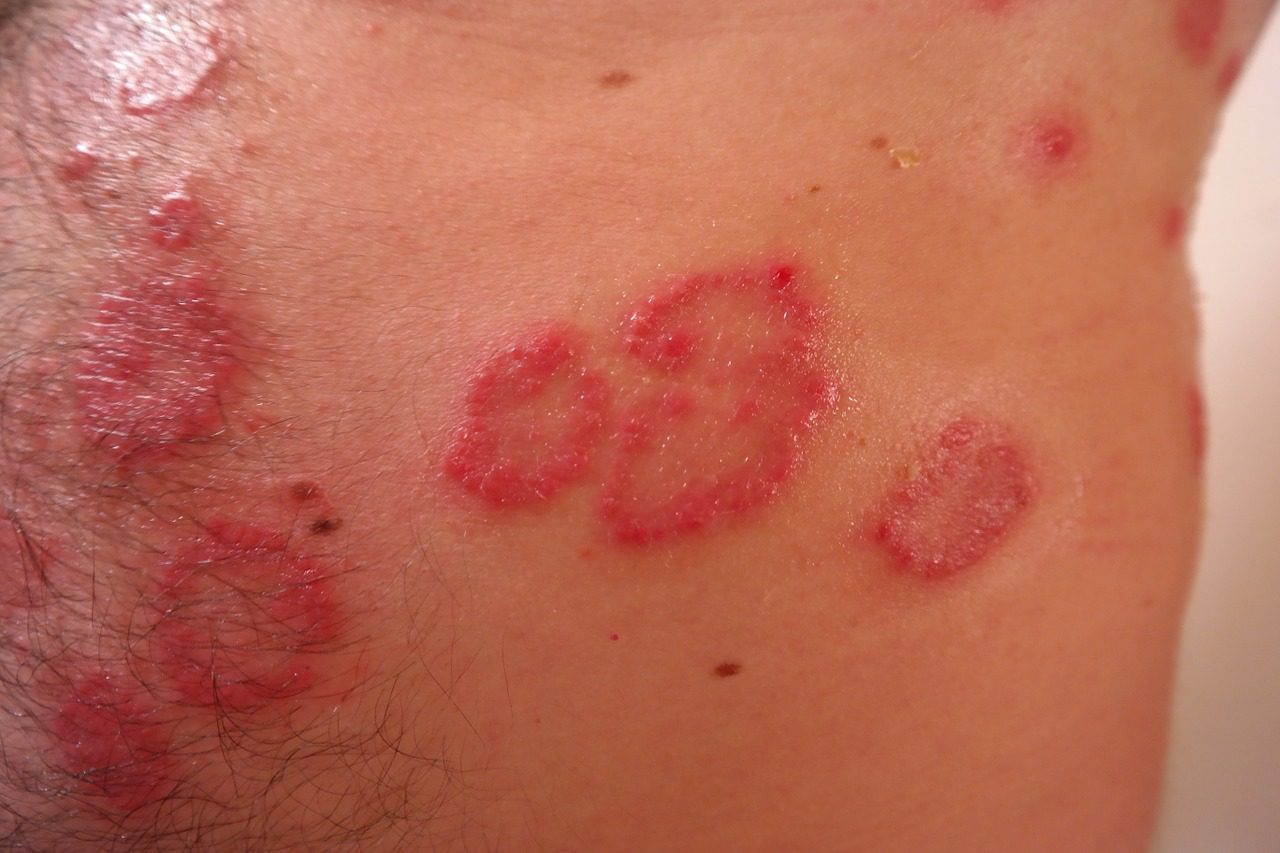Psoriasis is a chronic skin disorder which manifests externally on skin as white scaly patches, exfoliating, irregular, with itching, burning, in some severe cases as pus filled blisters, leaving the patches raw/sore after scratching. It can start as a small skin rash and may eventually spread to the other parts of the body.
It is one of the autoimmune disorder in which our immune system reacts abnormally to certain factors and aids in developing these types of diseases.
Normal skin is made up of layers of skin cells. The top layer of cells is flattened and gradually sheds-fall off. New cells are constantly being made underneath to replace the cells which shed off. Cells gradually move from basal layer to top horny layer. It normally takes 28 days for a cell in the basal layer to the top layer of the skin and shed there off. People with Psoriasis make more skin cells than normal and make them more quickly. The skin also becomes more inflamed.
It can be Genetic which run in families. It is not contagious-one cannot get it or give it to another by touching. Psoriasis can appear anywhere on the skin and patches can appear separately or join together to cover a large area. When patches and scales are in visible locations, people with psoriasis may feel self-conscious or withdraw socially.
There are certain types of psoriasis which we usually see,
1) Plaque – The most common form, causes dry raised, red skin lesions covered with silvery scales.
2) Nail – Psoriasis can affect fingernails and toenails causing pitting, abnormal nail growth and discoloration.
3) Guttate – This type primarily affects young adults and children. Usually triggered by bacterial infection such as strep throat.
4) Inverse – This mainly affects the skin in the armpits, groin, under the breast, around the genitals. Fungal infections may trigger this type of psoriasis.
5) Pustular – Can occurs in widespread patches generalized pustular psoriasis or in smaller areas on your hands, feet or fingertips. It generally develops quickly with pus filled blisters appearing just hours after your skin becomes red and tender. Generalized pustular psoriasis can also cause fever, chills, severe itching and diarrhea.
6) Erythrodermic psoriasis – The least common type of psoriasis, erythrodermic psoriasis can cover your entire body with a red, peeling rash that can itch or burn intensely.
7) Psoriatic arthritis – In addition to inflamed, scaly skin, psoriatic arthritis causes swollen, painful joints that are typical of arthritis. Sometimes the joint symptoms are the first or only manifestation of psoriasis or at times only nail changes are seen. Symptoms range from mild to severe and psoriatic arthritis can affect any joint.it can cause stiffness and progressive joint damage that may lead to permanent deformity.
There are different degrees of psoriasis –
- Mild – Symptoms cover less than 3% of your body
- Moderate – Symptoms cover 3 % to 10 % of your body
- Severe – Symptoms cover more than 10 % of your body
Diagnosing psoriasis can be sometimes hard as there are other skin problems such as eczema etc., mimic like. Your doctor will do a physical examination and review your symptoms. They may take biopsy of skin lesion and send to lab for investigation in order to confirm the diagnosis.


One cannot avoid psoriasis but can control it. People with psoriasis may have symptom free period followed by violent flare up of the diseases. There are certain trigger factors which are thought to provoke the flaring up in psoriasis individual. Some of them are,
Stress, dry skin, skin irritants, cold weather, smoking, infections, diseases that weaken the immune system, certain conventional medicines such as lithium, and drugs used for High Blood pressure-Beta blockers, and antimalarial drugs. Skin injury such as cut, scrape or bad sunburn. Injury to the skin, including excessive scratching may trigger a patch of psoriasis to develop. The development of psoriatic plaques where the skin has been damaged is termed as KOBNER’S REACTION. Psorasis may flare up in children two to six weeks after an earache, tonsillitis, bronchitis and some other respiratory infections, obesity-overweight. Hormonal changes-Psoriasis in women tends to be worst during puberty and menopause. These are times when there are major changes in female hormonal levels. Some pregnant women with psoriasis find that their symptoms improve when they are pregnant but it may flare-up in the months after delivery.
Although psoriasis is a skin disease, it can influence a person’s health in a number of different ways. For example, some people with psoriasis have an increased risk of developing psoriatic arthritis-one of the inflammatory forms of arthritis. About one-third of people with psoriasis get this type of arthritis which causes joint pain, stiffness. Without treatment psoriatic arthritis can cause severe structural damage/deformity. People with moderate to severe forms of psoriasis are at higher risk of Heart diseases such as heart attack, stroke etc.
Complications of psoriasis if not treated in time or neglected the condition may include-psoriatic arthritis, other auto-immune disorders, eye disorders, Parkinson’s disease, kidney disease, obesity, Type 2 Diabetes mellitus, High blood pressure, cardiovascular disorders, emotional disorders, metabolic syndrome
Homeopathy Treatment for Psoriasis
Homeopathy is safe and reliable method of treatment for psoriasis. It uses natural medicine with no side effects. They can be used by people of all age groups. They work by moderating the over active immune system. The initial aim is to manage the itching and burning sensation in the eruptions. In addition, healing of the current eruptions takes place along with the prevention of further spread of eruptions. Homeopathic medicines also are very beneficial for treating joint pains that are linked with psoriasis i.e., Psoriatic arthritis. We here in positive homeopathy with a team of well qualified doctors study each patient individually, considering patient’s physical, emotional symptoms and assessing in order to give the best possible treatment to the patient.








